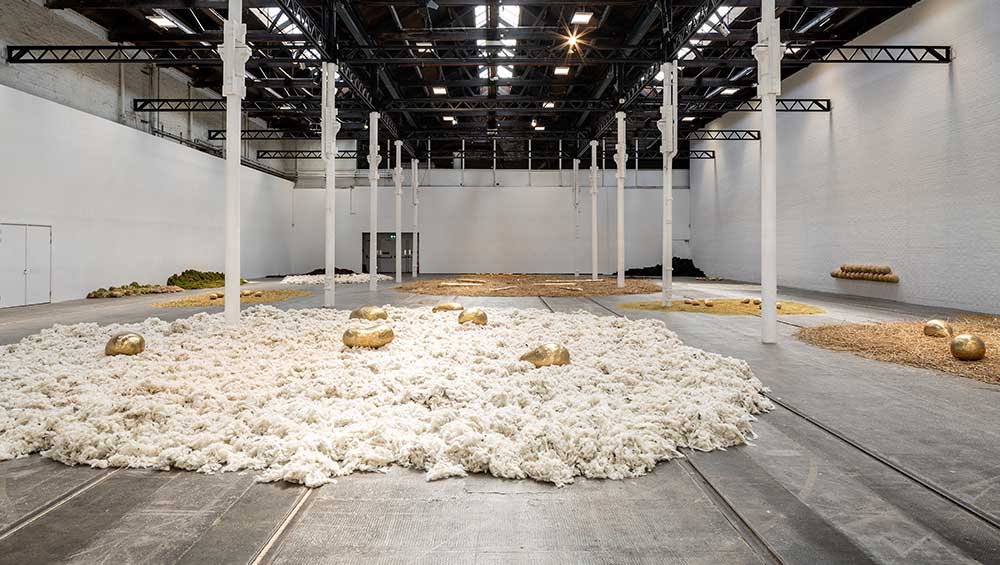
Solange Pessoa: Pilgrim Fields, installation view, Glasgow Tramway, 10 May – 5 October 2025. Photo: Keith Hunter.
Tramway, Glasgow
10 May – 5 October 2025
by VERONICA SIMPSON
It is quite the coup for Glasgow’s Tramway to have secured the first major UK solo exhibition of the Brazilian artist Solange Pessoa (b1961 Ferros Belo Horizonte, Brazil), whose drawings and installations were widely considered among the highlights of the 59th Venice Art Biennale, Milk of Dreams, in 2022. The large scale, black-and-white drawings (Sonhiferas, 2020-21) in the Arsenale and her installation of carved, pale stones (Nihil Novi Sub Sole, 2022) in the Giardino delle Vergini, felt like sacred communications from across the ages – channelling primal patterns of whorls, coils and dancing, amoebic forms that spoke of kinship with species, land and nature. Reminiscent of runes or cave paintings, they brought a sense of urgency very much in tune with this time of environmental degradation and social and species depletion.
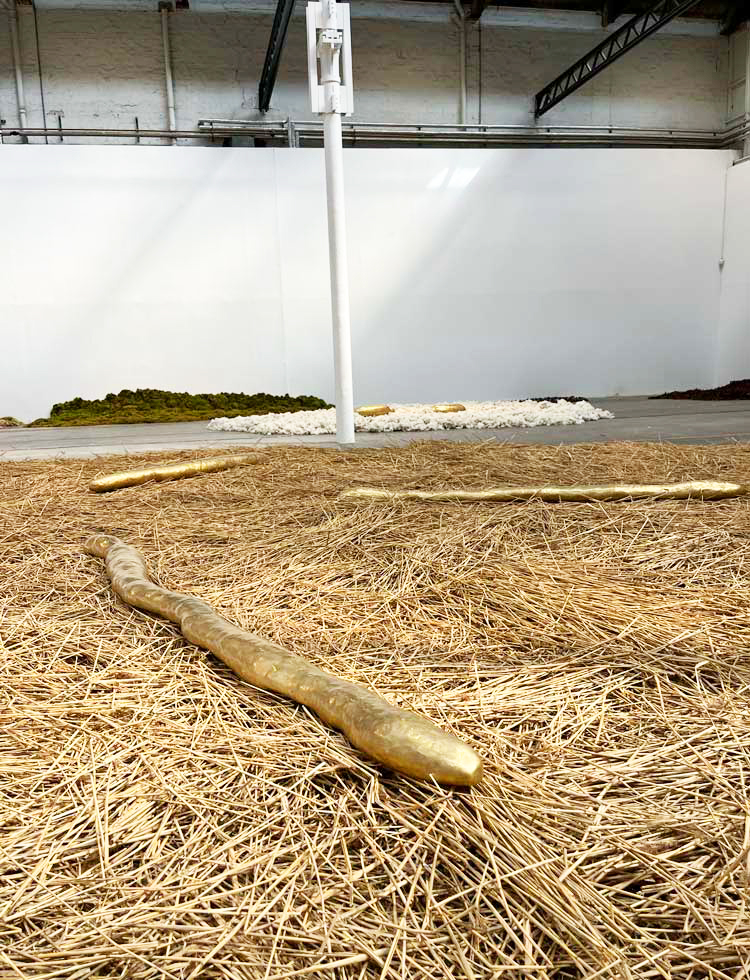
Solange Pessoa: Pilgrim Fields, installation view, Glasgow Tramway, 10 May – 5 October 2025. Photo: Veronica Simpson.
Pessoa’s work has long attracted admirers – and attention has increased in the belated recognition emerging during the last decade of so many women and artists from the global south. Though her fame has accelerated, her first US solo museum show was not until 2019, at Ballroom Marfa in Texas. It centred on her 1994 work Longilonge: a ceiling-hung waterfall of coffee sacks stuffed with earth, fruits, seeds, bones, poems and paper; for this iteration the sacks incorporated locally foraged materials. It then journeyed to Kunsthaus Bregenz in Austria in November 2023. Also in 2023, her solo show Earthworks ran at Mendes Wood DM, New York, transforming the white, gallery walls with an immersive mosaic of terracotta-hued cave paintings.
The foregrounding of nature and natural materials in sculptures and installations puts her firmly in dialogue with her Brazilian contemporary Ana Mendieta as well as the UK’s David Nash, with more than a dash of the elemental, deconstructed playfulness of fellow Brazilian, Lygia Clark. But, for me, this show brings another Brazilian contemporary, Ernesto Neto, most vividly to mind (or nose), not least for its foregrounding of the sense of smell.
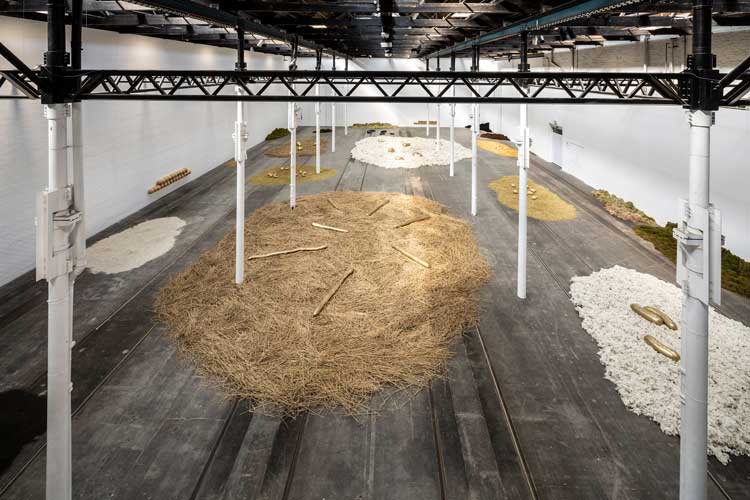
Solange Pessoa: Pilgrim Fields, installation view, Glasgow Tramway, 10 May – 5 October 2025. Photo: Keith Hunter.
To walk into the huge, hangar-like space of Tramway’s main gallery now is to enter a landscape and scentscape familiar yet strange. Visually, it is as if the windswept, watery moors of Scotland’s west coast have been translated indoors, but with a strange kind of material inversion: here the beaten concrete floor, still scored with tram tracks from its former incarnation as a tram depot, represents the sprawling expanses of heather, bracken and moss in the landscapes beyond Glasgow. And Pessoa’s pools of vegetation – assorted kinds of moss, sheepskin, reeds, flowers and hops – are scattered around this grey terrain, much like the shallow inland lochs or puddles decorate the heath, bringing such atmosphere and beauty to these bleak expanses when animated by an occasional, slender finger of sunshine. Here, those watery ripples and reflections are conjured by the many palely glowing bronze sculptures Pessoa has laid around these vegetal piles, especially when sunbeams burst through the Tramway’s original, dirt-smeared industrial rooflights. Luckily on my visit, there was plenty of sunshine to burnish these dimpled forms, some resembling eggs or beans, others gourds, and several long slender versions that evoke cigars, branches – or, possibly, fossilised turds. Further ceramic pellets and orbs are clustered around the margins of this space, along with groupings of nut husks and butternut squash.
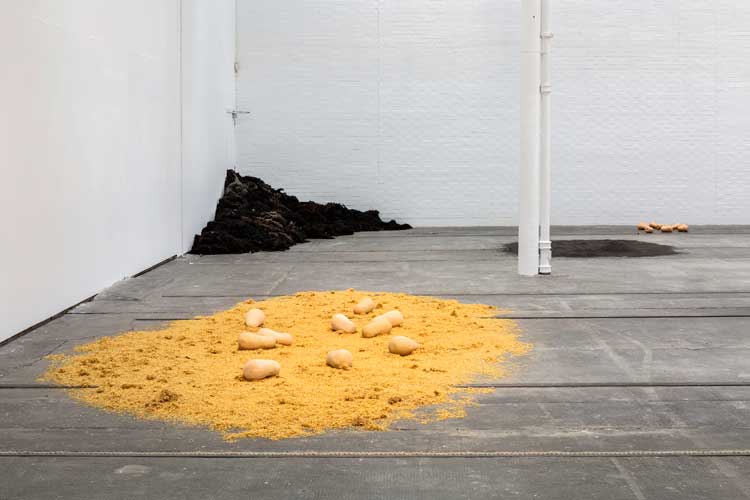
Solange Pessoa: Pilgrim Fields, installation view, Glasgow Tramway, 10 May – 5 October 2025. Photo: Keith Hunter.
The rich and varied aromas undoubtedly add enchantment to the visuals: dried marigold leaves in one pile, hops in another, safflower seeds, almond shells natural and dried, reeds taken from the nearby Tay reed bed, kelp sourced from the Scottish coast, and tangled beds of locally sourced sheepskin (unbleached and bleached), accompanied by drifts of moss in vivid greens and pinks (all sustainably farmed and sourced, I’m assured, from mossclerks.co.uk).
The organic world is always the spark for Pessoa, mediated through her continuing research with dreams, mythologies and the workings of the subconscious. And through this visceral, poetic and intuitive engagement with the land, her work can trigger an instant, bodily recognition. But there is conceptual punch here, too, subtly broadcasting a quiet, political as well as personal intensity.
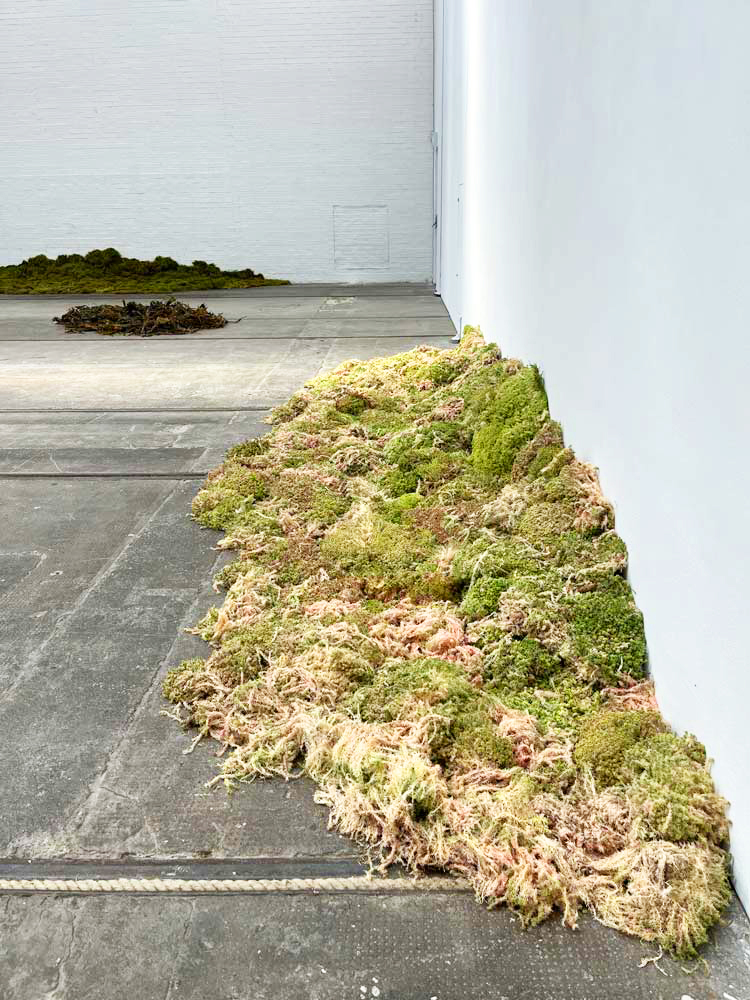
Solange Pessoa: Pilgrim Fields, installation view, Glasgow Tramway, 10 May – 5 October 2025. Photo: Veronica Simpson.
Pessoa lives and works between a studio in the city of Belo Horizonte and her family’s farm in Minas Gerais, in the south-east of Brazil – a verdant region named (it means General Mines) for the deep, extractive violence of mining that has been visited on the landscape over the centuries; it is known as Brazil’s “storehouse of mineral riches”, and this, together with its fertile slopes, help to make it Brazil’s third richest and second most populous state.
She brings something of that landscape and material palette wherever she goes, but also something of the place she has landed. She described her process (in a thoughtful interview with Whitewall magazine in 2023) as a deep immersion “through spatial research, through the local morphology, by looking into the local vegetation, the surrounding environment and its history, archaeology, and considering the time and space.” On her first visit to Tramway, she was apparently driven by the curatorial team up to Kilmartin Glen to look at palaeolithic sculptures, stopping at places along the way.
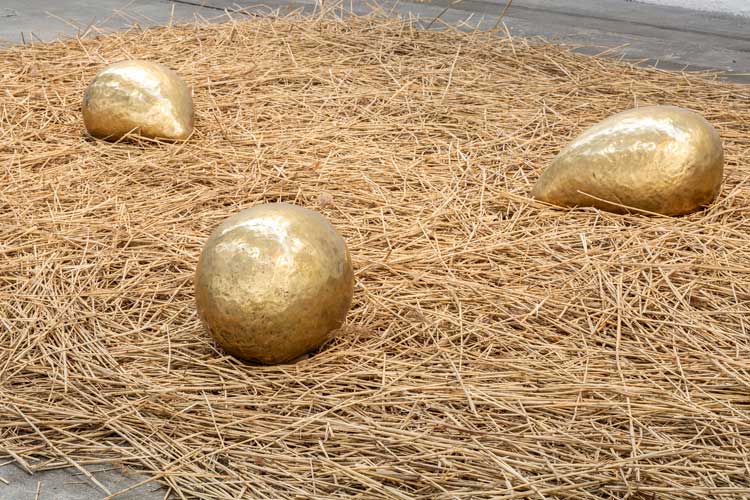
Solange Pessoa: Pilgrim Fields, installation view, Glasgow Tramway, 10 May – 5 October 2025. Photo: Keith Hunter.
There, she will have been all too aware – just as she is at home - of how agriculture and capitalism have shaped these landscapes we like to think of as wild. She may have learned that Scotland’s land owners’ decision to turn their arable land over to sheep farming was catastrophic for the local ecology, botanically, economically and socially, resulting in the “clearances” (roughly 1750-1860) of thousands of local people - the emotional and political scars from which still run deep. What I had not realised (until reading the captions) was that kelp was also a major source of employment, its ash widely used in the creation of glass and soap, but following tariffs imposed during the Napoleonic wars (ending 1822), that market collapsed.
The composition of this work and its materials are captivating. The mosses are especially appealing. Piled up in corners of the room, they take on a naturalistic quality, the moss seemingly drifting upwards and outwards as it would on a forest floor. I observe, however, that the dark, undyed fleeces of one breed of sheep – all rich tones of treacle and coffee – piled similarly beside a moss stack evoke something quite different; they seem to speak of neglect, of discarding, waste. Yet a similar shaped pile of dried tree leaves beside it somehow indicates artifice, crafting, care. You can read much into these piles of matter. We all carry our own associations and interactions, mentally and physically. You can read whatever you like. Pessoa is present while I tour the show but prefers not to be interrogated (she speaks no English, I speak no Portuguese), telling the curator: “The art speaks for itself.” While that is certainly not true of all contemporary artists, it is surely true for Pessoa’s work.
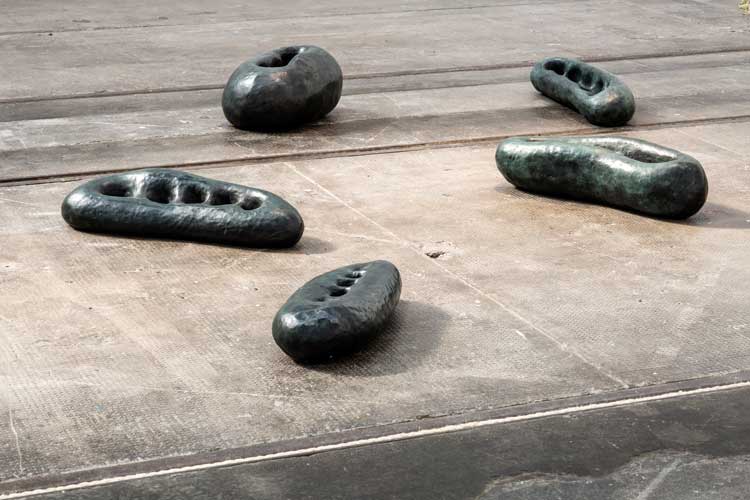
Solange Pessoa: Pilgrim Fields, installation view, Glasgow Tramway, 10 May – 5 October 2025. Photo: Keith Hunter.
I could spend hours in this space, breathing in these heady aromas, savouring the way the scentscapes shift as you move around the room, depending on what’s near, hops layering over grasses. There is a cluster of blackish, bronze forms – they could be stones, turds, fossilised remains – that have a Henry Moore-ish quality to them. They have no title, and are simply listed in the helpful material “map” provided as “Bronze sculpture with green patina”.
The title of the show, Pilgrim Fields, the exhibition leaflet tells us, “echoes the artist’s notion that the installation is an imagined ‘field’ or botanical system”. Pessoa proposes of seeds “as pilgrims, migrating and wandering the Earth”.
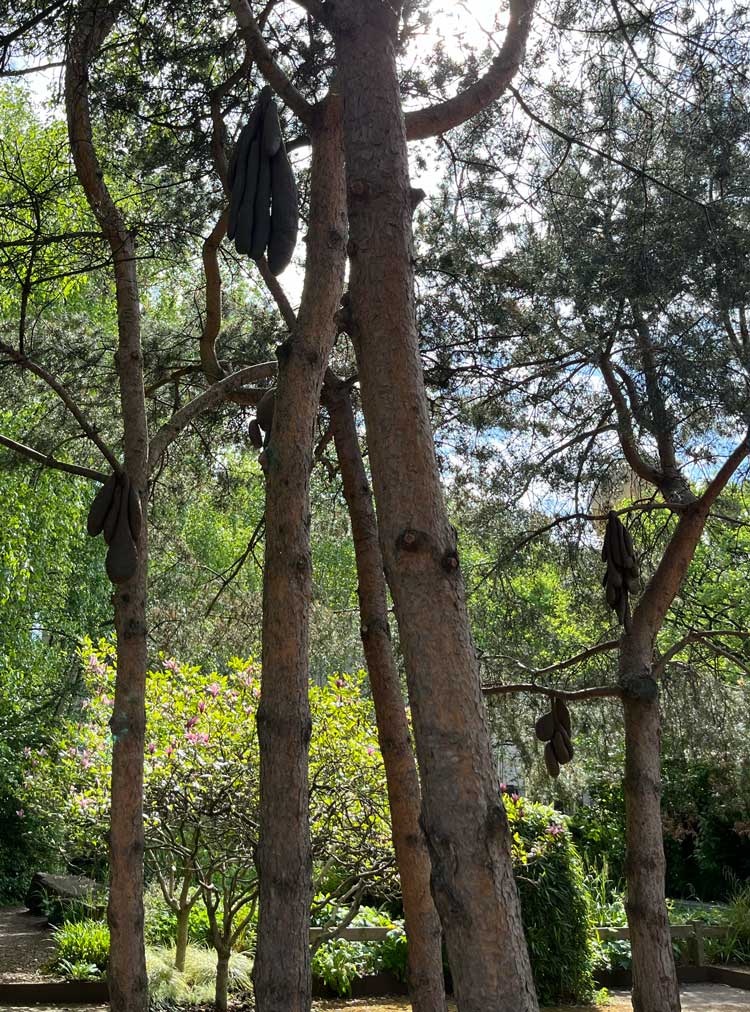
Lesmititas in the Hidden Garden, installation view, Solange Pessoa: Pilgrim Fields, Glasgow Tramway, 10 May – 5 October 2025. Photo: Veronica Simpson.
Another work is installed outside, Lesmititas (2025) in the Hidden Gardens – a pleasant expanse of grass and trees beyond the Tramway’s outdoor tables and chairs. The title of this new work is playing on the Portuguese word lesmas which translates as slugs, and slug-like forms are indeed dangling from the trees. Small textile sacks stuffed with earth, steeped in oil, they have a heavy, fleshy quality, evoking human appendages (earlobes, breasts, scrotal sacs) as well as rotting fruit, when they are draped in the trees. But placed around a slate-like surface at the base of this little glade of pine trees, they are more reminiscent of snakes, turds or remnants from past inhabitation.
A gnomic utterance of Pessoa’s from the Whitewall interview floats to mind: “I believe that I activate the viewer’s fond memories, intense sensations, hidden feelings, and telluric experiences with time, amongst other things.” She surely does.